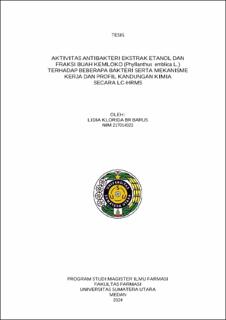| dc.description.abstract | Bacterial infection is a medical issue that necessitates effective treatment. Antibiotics have traditionally been the primary approach to treating bacterial infections; however, the rise in antibiotic resistance has prompted the exploration of other treatments. There has been interest in utilising natural materials as viable solutions to address this issue. This study aimed to test the antibacterial activity of extracts and fractions derived from kemloko fruit, typically known as Phyllanthus emblica L. against Staphylococcus aureus and Methicillin-resistant Staphylococcus aureus (MRSA) bacteria and their mechanism. The extraction process involved maceration using ethanol as the solvent, followed by fractionation using n-hexane and ethyl acetate solvents. The test of the antibacterial activity of the ethanol extract and each fraction by employing the diffusion method to measure the inhibition zone against several test bacteria, including Staphylococcus aureus and MRSA. The antibacterial action against the test bacterium is assessed by measuring protein and nucleic acid leakage by UV-Vis spectrophotometry. In addition, calcium and potassium metal ion leakage was evaluated using AAS. The chemical content of kemloko was analysed using LC-HRMS. The test findings of simplistic characterisation yielded a moisture content of 3.99% and an ethanol extract of 6.82%. The ethanol extract underwent phytochemical screening and was demonstrated to include alkaloids, flavonoids, glycosides, saponins, tannins, and steroid/triterpenoid compounds. The ethyl acetate fraction had the highest antibacterial activity against Staphylococcus aureus, with an inhibition diameter of 14.5 mm at an 80 mg/ml dose and an inhibition diameter of 14.7 mm against MRSA at a 100 mg/ml concentration. The ethyl acetate fraction used in the cell leakage test on Staphylococcus aureus bacteria resulted in higher protein leakage than nucleic acids. On the other hand, the release of Ca2+ ions from metal leakage was higher than that of K+ ions. The LC-HRMS analysis yielded flavonoid and phenolic chemicals, which are believed to possess antibacterial effects. | en_US |


